13 Chapter 13: Political Storms: Vietnam, Watergate, and the Reagan Revolution, 1968-1992
Political Storms: Vietnam, Watergate, and the Reagan Revolution, 1968-1992

Pop artist Peter Max designed this postage stamp to commemorate Expo ‘74, a world’s fair held in Spokane, Washington. The fair’s theme was the natural environment. Unfortunately, and ironically, gasoline shortages prevented many from attending the exposition. Source: Wikimedia Commons
Chapter Outline
Introduction, Watch and Learn, Questions to Guide Your Reading
13.1 Identity Politics in a Fractured Society
13.2 Coming Apart, Coming Together
13.3 Vietnam: The Downward Spiral
13.4 Watergate: Nixon’s Domestic Nightmare
13.5 Jimmy Carter in the Aftermath of the Storm
13.7 Political and Cultural Fusions
13.8 A New American Order
Summary Timelines, Chapter 13 Self-Test, Chapter 13 Key Terms Crossword Puzzle
Introduction
From May 4 to November 4, 1974, a universal exposition was held in the city of Spokane, Washington. This world’s fair, Expo ‘74, and the postage stamp issued to commemorate it, reflected many of the issues and interests of the late 1960s and 1970s. The stamp features psychedelic colors, and the character of the Cosmic Runner in the center wears bellbottoms, a popular fashion at the time. The theme of the fair was the environment, a subject beginning to be of great concern to people in the United States, especially the younger generation and those in the hippie counterculture. In the 1970s, the environment, social justice, distrust of the government, and a desire to end the war in Vietnam—the concerns and attitudes of younger people, women, gays and lesbians, and people of color—began to draw the attention of the mainstream as well.
“Act up!” might be called the unofficial slogan of the 1980s. Numerous groups were concerned by what they considered disturbing social, cultural, and political trends in the United States and lobbied for their vision of what the nation should be. Conservative politicians cut taxes for the wealthy and shrank programs for the poor, while conservative Christians blamed the legalization of abortion and the increased visibility of gays and lesbians for weakening the American family. When the U.S. Centers for Disease Control first recognized the Acquired Immune Deficiency Syndrome (AIDS) in 1981, the Religious Right regarded it as a plague sent by God to punish homosexual men for their “unnatural” behavior. Politicians, many of whom relied on religious conservatives for their votes, largely ignored the AIDS epidemic. In response, gay men and women formed organizations such as ACT UP to draw attention to their cause
Toward the end of the decade in 1989, protesters from both East and West Berlin began “acting up” and tearing down large chunks of the Berlin Wall, essentially dismantling the Iron Curtain. This symbolic act was the culmination of earlier demonstrations that had swept across Eastern Europe, resulting in the collapse of Communist governments in both Central and Eastern Europe, and marking the beginning of the end of the Cold War.
This striking piece of graffiti from the Berlin Wall, now housed in the Newseum in Washington, DC, contains the name of the AIDS Coalition to Unleash Power (ACT UP), a group formed in 1987 in New York City to combat the spread of AIDS and the perception that AIDS was the product of immoral behavior.
Watch and Learn
- Women and the Black Power Movement
- Martha P. Johnson and the Stonewall Rebellion
- The Rise of Conservatism
- Ford, Carter, and Economic Malaise
- The Reagan Revolution
- The War on Drugs
- George HW Bush and the End of the Cold War
Questions to Guide Your Reading
- What common goals did American Indians, gay and lesbian citizens, and women share in their quests for equal rights? How did their agendas differ? What were the differences and similarities in the tactics they used to achieve their aims?
- In what ways were the policies of Richard Nixon different from those of his Democratic predecessors John Kennedy and Lyndon Johnson? How were Jimmy Carter’s policies different from those of Nixon?
- To what degree did foreign policy issues affect politics and the economy in the United States in the late 1960s and 1970s?
- What events caused voters to lose faith in the political system and the nation’s leaders in the late 1960s and 1970s?
- What were some of the long-term effects of the Reagan Revolution and the rise of conservatives?
- What events led to the end of the Cold War? What impact did the end of the Cold War have on American politics and foreign policy concerns?
- Which issues divided Americans most significantly during the culture wars of the 1980s and 1990s?
13.1 Identity Politics in a Fractured Society
Learning Objectives
By the end of this section, you will be able to:
- Describe the counterculture of the 1960s
- Explain the origins of the American Indian Movement and its major activities
- Assess the significance of the gay rights and women’s liberation movements
The political divisions that plagued the United States in the 1960s were reflected in the rise of identity politics in the 1970s. As people lost hope of reuniting as a society with common interests and goals, many focused on issues of significance to the subgroups to which they belonged, based on culture, ethnicity, sexual orientation, gender, and religion.
HIPPIES AND THE COUNTERCULTURE
In the late 1960s and early 1970s, many young people came to embrace a new wave of cultural dissent. The counterculture offered an alternative to the bland homogeneity of American middle-class life, patriarchal family structures, self-discipline, unquestioning patriotism, and the acquisition of property. In fact, there were many alternative cultures.
“Hippies” rejected the conventions of traditional society. Men sported beards and grew their hair long; both men and women wore clothing from non-Western cultures, defied their parents, rejected social etiquettes and manners, and turned to music as an expression of their sense of self. Casual sex between unmarried men and women was acceptable. Drug use, especially of marijuana and psychedelic drugs like LSD and peyote, was common. Most hippies were also deeply attracted to the ideas of peace and freedom. They protested the war in Vietnam and preached a doctrine of personal freedom to be and act as one wished.
Some hippies dropped out of mainstream society altogether and expressed their disillusionment with the cultural and spiritual limitations of American freedom. They joined communes, usually in rural areas, to share a desire to live closer to nature, respect for the earth, a dislike of modern life, and a disdain for wealth and material goods. Many communes grew their own organic food. Others abolished the concept of private property, and all members shared willingly with one another. Some sought to abolish traditional ideas regarding love and marriage, and free love was practiced openly.

The crowd at Woodstock greatly exceeded the fifty thousand expected. Mark Goff covered Woodstock as a young freelance reporter for Kaleidoscope, a Milwaukee-based alternative newspaper, and captured this image of Swami Satchidananda, who declared music “’the celestial sound that controls the whole universe” at the opening ceremony. Source: Wikimedia Commons
Music, especially rock and folk music, occupied an important place in the counterculture. Concerts provided the opportunity to form seemingly impromptu communities to celebrate youth, rebellion, and individuality. In mid-August 1969, nearly 400,000 people attended a music festival in rural Bethel, New York, many for free. They jammed roads throughout the state, and thousands had to be turned around and sent home. Thirty-two acts performed for a crowd that partook freely of marijuana, LSD, and alcohol during the rainy three-day event that became known as Woodstock (after the nearby town) and became the cultural touchstone of a generation. No other event better symbolized the cultural independence and freedom of Americans coming of age in the 1960s.
|
|
MY STORY |
|
Glenn Weiser on Attending Woodstock On the way to Woodstock, Glenn Weiser remembers that the crowds were so large they essentially turned it into a free concert: As we got closer to the site [on Thursday, August 14, 1969] we heard that so many people had already arrived that the crowd had torn down the fences enclosing the festival grounds (in fact they were never put up to begin with). Everyone was being allowed in for free. . . . Early on Friday afternoon about a dozen of us got together and spread out some blankets on the grass at a spot about a third of the way up the hill on stage right and then dropped LSD. I took Orange Sunshine, a strong, clean dose in an orange tab that was perhaps the best street acid ever. Underground chemists in southern California had made millions of doses, and the nation was flooded with it that summer. We smoked some tasty black hashish to amuse ourselves while waiting for the acid to hit, and sat back to groove along with Richie Havens. In two hours we were all soaring, and everything was just fine. In fact, it couldn’t have been better—there I was with my beautiful hometown friends, higher than a church steeple and listening to wonderful music in the cool summer weather of the Catskills. After all, the dirty little secret of the late ‘60s was that psychedelic drugs taken in a pleasant setting could be completely exhilarating. —Glenn Weiser, “Woodstock 1969 Remembered” |
|
AMERICAN INDIAN PROTEST
As the young, primarily white men and women who became hippies strove to create new identities for themselves, they borrowed liberally from other cultures, including that of Native Americans. At the same time, many Indians were themselves seeking to maintain their culture or retrieve elements that had been lost. In 1968, a group of Indian activists, including Dennis Banks, George Mitchell, and Clyde Bellecourt, convened a gathering of two hundred people in Minneapolis, Minnesota, and formed the American Indian Movement (AIM). The organizers were urban dwellers frustrated by decades of poverty and discrimination. In 1970, the average life expectancy of Indians was forty-six years compared to the national average of sixty-nine. The suicide rate was twice that of the general population, and the infant mortality rate was the highest in the country. Half of all Indians lived on reservations, where unemployment reached 50 percent. Among those in cities, 20 percent lived below the poverty line.

This teepee was erected on the National Mall near the Washington Monument as part of an AIM demonstration (a). Note that the AIM flag (b) combines an Indian silhouette with the peace sign, the ubiquitous symbol of the 1960s and ‘70s. Source: Wikimedia Commons
On November 20, 1969, a small group of Indian activists landed on Alcatraz Island (the former site of a notorious federal prison) in San Francisco Bay. They announced plans to build an American Indian cultural center, including a history museum, an ecology center, and a spiritual sanctuary. People on the mainland provided supplies by boat, and celebrities visited Alcatraz to publicize the cause. More people joined the occupiers until, at one point, they numbered about four hundred. From the beginning, the federal government negotiated with them to persuade them to leave. They were reluctant to accede, but over time, the occupiers began to drift away of their own accord. Government forces removed the final holdouts on June 11, 1971, nineteen months after the occupation began.
|
|
DEFINING “AMERICAN” |
|
Proclamation to the Great White Father and All His People In occupying Alcatraz Island, Indian activists sought to call attention to their grievances and expectations about what America should mean. At the beginning of the nineteen-month occupation, Mohawk Richard Oakes delivered the following proclamation: We, the native Americans, re-claim the land known as Alcatraz Island in the name of all American Indians by right of discovery. We wish to be fair and honorable in our dealings with the Caucasian inhabitants of this land, and hereby offer the following treaty: We will purchase said Alcatraz Island for twenty-four dollars ($24) in glass beads and red cloth, a precedent set by the white man’s purchase of a similar island about 130 years ago. … We feel that this so-called Alcatraz Island is more than suitable for an Indian Reservation, as determined by the white man’s own standards. By this we mean that this place resembles most Indian reservations in that: It is isolated from modern facilities, and without adequate means of transportation. It has no fresh running water. It has inadequate sanitation facilities. There are no oil or mineral rights. There is no industry and so unemployment is very great. There are no health care facilities. The soil is rocky and non-productive; and the land does not support game. There are no educational facilities. The population has always exceeded the land base. The population has always been held as prisoners and kept dependent upon others. Further, it would be fitting and symbolic that ships from all over the world, entering the Golden Gate, would first see Indian land, and thus be reminded of the true history of this nation. This tiny island would be a symbol of the great lands once ruled by free and noble Indians. |
|
The next major demonstration came in 1972 when AIM members and others marched on Washington, DC—a journey they called the “Trail of Broken Treaties”—and occupied the offices of the Bureau of Indian Affairs (BIA). The group presented a list of demands, which included improved housing, education, and economic opportunities in Indian communities; the drafting of new treaties; the return of Indian lands; and protections for native religions and culture.
The most dramatic event staged by AIM was the occupation of the Indian community of Wounded Knee, South Dakota, in February 1973. Wounded Knee, on the Pine Ridge Indian Reservation, had historical significance: It was the site of an 1890 massacre of members of the Lakota tribe by the U.S. Army. AIM went to the reservation following the failure of a group of Oglala to impeach the tribal president Dick Wilson, whom they accused of corruption and the use of strong-arm tactics to silence critics. AIM used the occasion to criticize the U.S. government for failing to live up to its treaties with native peoples.
The federal government surrounded the area with U.S. marshals, FBI agents, and other law enforcement forces. A siege ensued that lasted seventy-one days, with frequent gunfire from both sides, wounding a U.S. marshal as well as an FBI agent, and killing two Indians. The government did very little to meet the protesters’ demands. Two AIM leaders, Dennis Banks and Russell Means, were arrested, but charges were later dismissed. The Nixon administration had already halted the federal policy of termination and restored millions of acres to tribes. Increased funding for Indian education, healthcare, legal services, housing, and economic development followed, along with the hiring of more Indian employees in the BIA.
GAY RIGHTS
Combined with the sexual revolution and the feminist movement of the 1960s, the counterculture helped establish a climate that fostered the struggle for gay and lesbian rights. Many gay rights groups were founded in Los Angeles and San Francisco, cities that were administrative centers in the network of U.S. military installations and the places where many gay men suffered dishonorable discharges. The first postwar organization for homosexual civil rights, the Mattachine Society, was launched in Los Angeles in 1950. The first national organization for lesbians, the Daughters of Bilitis, was founded in San Francisco five years later. In 1966, the city became home to the world’s first organization for transsexual people, the National Transsexual Counseling Unit, and in 1967, the Sexual Freedom League of San Francisco was born.
Through these organizations and others, gay and lesbian activists fought against the criminalization and discrimination of their sexual identities on a number of occasions throughout the 1960s, employing strategies of both protests and litigation. However, the most famous event in the gay rights movement took place not in San Francisco but in New York City. Early in the morning of June 28, 1969, police raided a Greenwich Village gay bar called the Stonewall Inn. Although such raids were common, the response of the Stonewall patrons was anything but. As the police prepared to arrest many of the customers, especially transsexuals and cross-dressers, who were particular targets for police harassment, a crowd began to gather. Angered by the brutal treatment of the prisoners, the crowd attacked. Beer bottles and bricks were thrown. The police barricaded themselves inside the bar and waited for reinforcements. The riot continued for several hours and resumed the following night. Shortly thereafter, the Gay Liberation Front and Gay Activists’ Alliance were formed, and began to protest discrimination, homophobia, and violence against gay people, promoting gay liberation and gay pride.
With a call for gay men and women to “come out”—a consciousness-raising campaign that shared many principles with the counterculture, gay and lesbian communities moved from the urban underground into the political sphere. Gay rights activists protested strongly against the official position of the American Psychiatric Association (APA), which categorized homosexuality as a mental illness and often resulted in job loss, loss of custody, and other serious personal consequences. By 1974, the APA had ceased to classify homosexuality as a form of mental illness but continued to consider it a “sexual orientation disturbance.” Nevertheless, in 1974, Kathy Kozachenko became the first openly lesbian woman voted into office in Ann Arbor, Michigan. In 1977, Harvey Milk (shown in the picture below) became California’s first openly gay man elected to public office, although his service on San Francisco’s board of supervisors, along with that of San Francisco mayor George Moscone, was cut short by the bullet of disgruntled former city supervisor Dan White.

MAYBE NOT NOW
The feminist push for greater rights continued through the 1970s. Feminists opened battered women’s shelters and successfully fought for protection from employment discrimination for pregnant women, reform of rape laws (such as the abolition of laws requiring a witness to corroborate a woman’s report of rape), criminalization of domestic violence, and funding for schools that sought to counter sexist stereotypes of women. In 1973, the U.S. Supreme Court in Roe v. Wade affirmed a number of state laws under which abortions obtained during the first three months of pregnancy were legal. This made a nontherapeutic abortion a legal medical procedure nationwide.
Many advances in women’s rights were the result of women’s greater engagement in politics. For example, Patsy Mink, the first Asian American woman elected to Congress, was the co-author of the Education Amendments Act of 1972, Title IX of which prohibits sex discrimination in education. Mink had been interested in fighting discrimination in education since her youth, when she opposed racial segregation in campus housing while a student at the University of Nebraska. She went to law school after being denied admission to medical school because of her gender. Like Mink, many other women sought and won political office, many with the help of the National Women’s Political Caucus (NWPC). In 1971, the NWPC was formed by Bella Abzug, Gloria Steinem, Shirley Chisholm, and other leading feminists to encourage women’s participation in political parties, elect women to office, and raise money for their campaigns

Patsy Mink (a), a Japanese American from Hawaii, was the first Asian American woman elected to the House of Representatives. In her successful 1970 congressional campaign, Bella Abzug (b) declared, “This woman’s place is in the House… the House of Representatives!” Source: Wikimedia Commons
The ultimate political goal of the National Organization for Women (NOW) was the passage of an Equal Rights Amendment (ERA). The amendment passed Congress in March 1972 and was sent to the states for ratification with a deadline of seven years for passage; if the amendment was not ratified by thirty-eight states by 1979, it would die. Twenty-two states ratified the ERA in 1972, and eight more in 1973. In the next two years, only four states voted for the amendment. In 1979, still four votes short, the amendment received a brief reprieve when Congress agreed to a three-year extension, but it never passed, as the result of the well-organized opposition of Christian and other socially conservative, grassroots organizations.

In 1970, supporters of equal rights for women marched in Washington, DC. Source: Wikimedia Commons
13.1 Section Summary
In the late 1960s and 1970s, Indians, gays and lesbians, and women organized to change discriminatory laws and pursue government support for their interests, a strategy known as identity politics. Others, disenchanted with the status quo, distanced themselves from white, middle-class America by forming their own countercultures centered on a desire for peace, the rejection of material goods and traditional morality, concern for the environment, and drug use in pursuit of spiritual revelations. These groups, whose aims and tactics posed a challenge to the existing state of affairs, often met with hostility from individuals, local officials, and the U.S. government alike. Still, they persisted, determined to further their goals and secure for themselves the rights and privileges to which they were entitled as American citizens.
13.2 Coming Apart, Coming Together
Learning Objectives
By the end of this section, you will be able to:
- Explain the factors responsible for Richard Nixon’s election in 1968
- Describe the splintering of the Democratic Party in 1968
- Discuss Richard Nixon’s domestic and foreign policies
The presidential election of 1968 revealed a rupture of the New Deal coalition that had come together under Franklin Roosevelt in the 1913s. The Democrats were divided by internal dissension over the Vietnam War, the civil rights movement, and the challenges of the New Left. Meanwhile, the Republican candidate, Richard Nixon, won voters in the South, Southwest, and northern suburbs by appealing to their anxieties about civil rights, women’s rights, antiwar protests, and the counterculture taking place around them. Nixon spent his first term in office pushing measures that slowed the progress of civil rights and sought to restore economic stability. His greatest triumphs were in foreign policy. But his largest priority throughout his first term was his reelection in 1972.
THE “NEW NIXON”
Nixon employed a southern strategy in 1968. Denouncing segregation and the denial of the vote to African Americans, he nevertheless maintained that southern states be allowed to pursue racial equality at their own pace and criticized forced integration. Nixon also courted northern, blue-collar workers, whom he later called the silent majority, to acknowledge their belief that their voices were seldom heard. These voters feared the social changes taking place in the country: Antiwar protests challenged their own sense of patriotism and civic duty, whereas the recreational use of new drugs threatened their cherished principles of self-discipline, and urban riots invoked the specter of a racial reckoning. Government action on behalf of the marginalized raised the question of whether its traditional constituency—the white middle class—would lose its privileged place in American politics. Some felt left behind as the government turned to the problems of African Americans. Nixon’s promises of stability and his emphasis on law and order appealed to them. He portrayed himself as a fervent patriot who would take a strong stand against racial unrest and antiwar protests. Nixon harshly critiqued Lyndon Johnson’s Great Society, and he promised a secret plan to end the war in Vietnam honorably and bring home the troops. He also promised to reform the Supreme Court, which he contended had gone too far in “coddling criminals.”

On the 1968 campaign trail, Richard Nixon flashes his famous “V for Victory” gesture (a). Nixon’s strategy was to appeal to working- and middle-class suburbanites. This image of him in the White House bowling alley seems calculated to appeal to his core constituency (b). Source: Wikimedia Commons
Nixon had found the political capital that would ensure his victory in the suburbs, which produced more votes than either urban or rural areas. He championed “middle America,” which was fed up with social convulsions, and called upon the country to come together. His running mate, Spiro T. Agnew, a former governor of Maryland, blasted the Democratic ticket as fiscally irresponsible and “soft on communism.” Nixon and Agnew’s message thus appealed to northern middle-class and blue-collar whites as well as southern whites who had fled to the suburbs in the wake of the Supreme Court’s pro-integration decision in Brown v. Board of Education.
DEMOCRATS IN DISARRAY
By contrast, in early 1968, the political constituency that Lyndon Johnson had cobbled together to win the presidency in 1964 was fracturing. One faction consisted of the traditional party leaders who appealed to unionized, blue-collar constituents and white ethnics (Americans with recent European immigrant backgrounds). The second group consisted of idealistic young activists and saw themselves as the future of the Democratic Party. A third group was composed of Catholics, African Americans and other minorities, and some of the young, antiwar element. Finally, there were the southern Democrats, the Dixiecrats, who opposed the advances made by the civil rights movement.
In-fighting between factions and their candidates split the party. A chaotic scene developed both inside the 1968 Democratic convention and outside at Grant Park, where protesters were camped. The protesters were a mixed group of were antiwar protestors, hippies, and Yippies—members of the leftist, anarchistic Youth International Party organized by Jerry Rubin and Abbie Hoffman—who called for the establishment of a new nation consisting of cooperative institutions to replace those currently in existence.
Chicago’s mayor, Richard J. Daley, was anxious to demonstrate that he could maintain law and order. He thus let loose a force of twelve thousand police officers, six thousand members of the Illinois National Guard, and six thousand U.S. Army soldiers. Television cameras caught what later became known as a “police riot.” Armed officers made their way into crowds of law-abiding protesters, clubbing anyone they encountered and setting off tear gas canisters. The protesters fought back. Inside the convention hall, a Democratic senator from Connecticut called for adjournment, whereas other delegates insisted on proceeding. Ironically, Hubert Humphrey received the Democratic nomination and gave an acceptance speech in which he spoke in support of “law and order.” When the convention ended, Rubin, Hoffman, and five other protesters (called the “Chicago Seven”) were placed on trial for inciting a riot

Despite facing charges following events at the Democratic National Convention in Chicago, Abbie Hoffman continued to protest the war on campuses across the country, as here (a) at the University of Oklahoma. Jerry Rubin (b) visited the campus of the University of Buffalo in March 1970, just one month after his conviction in the Chicago Seven trial. Source: Wikimedia Commons
THE DOMESTIC NIXON
The images of violence and the impression of things spinning out of control seriously damaged Humphrey’s chances for victory. Many loyal Democratic voters at home, shocked by the violence they saw on television, turned away from their party, which seemed to have attracted dangerous “radicals,” and began to consider Nixon’s promises of law and order. As the Democratic Party collapsed, Nixon successfully campaigned for the votes of both working- and middle-class white Americans, winning the 1968 election.
Once elected, Nixon began to pursue a policy of deliberate neglect of the civil rights movement and the needs of ethnic minorities. For example, in 1969, for the first time in fifteen years, federal lawyers sided with the state of Mississippi when it sought to slow the pace of school desegregation. Similarly, Nixon consistently showed his opposition to busing to achieve racial desegregation. He saw that restricting African American activity was a way of undercutting a source of votes for the Democratic Party and sought to overhaul the provisions of the Voting Rights Act of 1965. In March 1970, he commented that he did not believe an “open” America had to be homogeneous or fully integrated, maintaining that it was “natural” for members of ethnic groups to live together in their own enclaves. In other policy areas, especially economic ones, Nixon was either moderate or supportive of the progress of African Americans; for example, he expanded affirmative action, a program begun during the Johnson administration to improve employment and educational opportunities for racial minorities.
Although Nixon always kept his eye on the political environment, the economy required attention. The nation had enjoyed seven years of expansion since 1961, but inflation (a general rise in prices) was threatening to constrict the purchasing power of the American consumer and therefore curtail economic expansion. By mid-1970, a recession was beginning and unemployment was 6.2 percent, twice the level under Johnson. After earlier efforts at controlling inflation with controlled federal spending—economists assumed that reduced federal spending and borrowing would curb the amount of money in circulation and stabilize prices—Nixon proposed a budget with an $11 billion deficit in 1971. The hope was that more federal funds in the economy would stimulate investment and job creation. At the same time, he tried to fight continuing inflation by freezing wages and prices for ninety days, which proved to be only a temporary fix. The combination of unemployment and rising prices posed an unfamiliar challenge to economists whose fiscal policies of either expanding or contracting federal spending could only address one side of the problem at the cost of the other. This phenomenon of “stagflation”—a term that combined the economic conditions of stagnation and inflation—outlived the Nixon administration, enduring into the early 1980s.
The situation was made worse in October 1973, when Syria and Egypt jointly attacked Israel to recover territory that had been lost in 1967, starting the Yom Kippur War. The Soviet Union significantly aided its allies, Egypt and Syria, and the United States supported Israel, earning the enmity of Arab nations. In retaliation, the Organization of Arab Petroleum Exporting Countries (OAPEC) imposed an embargo on oil shipments to the United States from October 1973 to March 1974. The ensuing shortage of oil pushed its price from three dollars a barrel to twelve dollars a barrel. The average price of gasoline in the United States shot from thirty-eight cents a gallon before the embargo to fifty-five cents a gallon in June 1974 and the prices of other goods whose manufacture and transportation relied on oil or gas also rose and did not come down. The oil embargo had a lasting impact on the economy and underscored the nation’s interdependency with international political and economic developments.

The oil shortage triggered a rush to purchase gasoline, and gas stations around the country were choked with cars waiting to fill up. Eventually, fuel shortages caused gas stations to develop various ways to ration gasoline to their customers (a), such as the “flag policy” used by gas dealers in Oregon (b). Source: Wikimedia Commons
Faced with high fuel prices, American consumers panicked. Gas stations limited the amount customers could purchase and closed on Sundays as supplies ran low. To conserve oil, Congress reduced the speed limit on interstate highways to fifty-five miles per hour. People were asked to turn down their thermostats, and automobile manufacturers in Detroit explored the possibility of building more fuel-efficient cars. Even after the embargo ended, prices continued to rise, and by the end of the Nixon years in 1974, inflation had soared to 12.2 percent.
NIXON THE DIPLOMAT
Despite the many domestic issues on Nixon’s agenda, he prioritized foreign policy and clearly preferred bold and dramatic actions in that arena. Realizing that five major economic powers—the United States, Western Europe, the Soviet Union, China, and Japan—dominated world affairs, he sought opportunities for the United States to pit the others against each other. In 1969, he announced a new Cold War principle known as the Nixon Doctrine, a policy whereby the United States would continue to assist its allies but would not assume the responsibility of defending the entire non-Communist world.
Playing what was later referred to as “the China card,” Nixon abruptly reversed two decades of U.S. diplomatic sanctions and hostility to the Communist regime in the People’s Republic of China, when he announced, in August 1971, that he would personally travel to Beijing and meet with China’s leader, Chairman Mao Zedong, in February 1972. Nixon hoped that opening up to the Chinese government would prompt its bitter rival, the Soviet Union, to compete for global influence and seek a more productive relationship with the United States. He also hoped that establishing a friendly relationship with China would isolate North Vietnam and ease a peace settlement, allowing the United States to extract its troops from the war honorably. Nixon and Chinese premier Zhou Enlai ended up signing a friendship treaty. They promised to work towards establishing trade between the two nations and to eventually establishing full diplomatic relations with each other.

President Nixon and First Lady Patricia Nixon visited the Great Wall on their 1972 trip to China. The Chinese showed them the sights and hosted a banquet for them in the Great Hall of the People. Nixon was the first U.S. president to visit China following the Communist victory in the civil war in 1949. Source: Wikimedia Commons
Continuing his strategy of pitting one Communist nation against another, in May 1972, Nixon made another newsworthy trip, traveling to Moscow to meet with the Soviet leader Leonid Brezhnev. The two discussed a policy of détente, a relaxation of tensions between their nations, and signed the Strategic Arms Limitation Treaty (SALT), which limited each side to deploying only two antiballistic missile systems. It also limited the number of nuclear missiles maintained by each country. In 1974, a protocol was signed that reduced antiballistic missile sites to one per country, since neither country had yet begun to build its second system. Moreover, the two sides signed agreements to allow scientific and technological exchanges and promised to work towards a joint space mission.
13.2 Section Summary
When a new Republican constituency of moderate southerners and northern, blue-collar workers voted Richard Nixon into the White House in 1968, many were hopeful. In the wake of antiwar and civil rights protests, and the chaos of the 1968 Democratic National Convention, many Americans welcomed Nixon’s promise to uphold law and order. During his first term, Nixon strode a moderate, middle path in domestic affairs, attempting with little success to solve the problems of inflation and unemployment through a combination of austerity and deficit spending. He made substantial progress in foreign policy, however, establishing diplomatic relations with China for the first time since the Communist Revolution and entering into a policy of détente with the Soviet Union.
13.3 Vietnam: The Downward Spiral
Learning Objectives
By the end of this section, you will be able to:
- Describe the events that fueled antiwar sentiment in the Vietnam era
- Explain Nixon’s steps to withdraw the United States from the conflict in South Vietnam
As early as 1967, critics of the war in Vietnam had begun to call for the repeal of the Gulf of Tonkin Resolution, which gave President Johnson the authority to conduct military operations in Vietnam in defense of an ally, South Vietnam. Nixon initially opposed the repeal efforts, claiming that doing so might have consequences that reached far beyond Vietnam. Nevertheless, by 1969, he was beginning troop withdrawals from Vietnam while simultaneously looking for a “knockout blow” against the North Vietnamese. In sum, the Nixon administration was in need of an exit strategy.
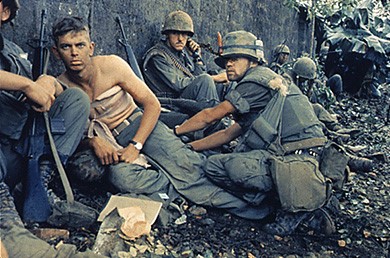
U.S. soldiers in Hue in 1968 during the Tet Offensive. The frustrating experience of fighting the seemingly unwinnable war left many soldiers, and the public in general, disillusioned with the government. Source: Wikimedia Commons
MY LAI
Racism on the part of some U.S. soldiers and a desire to retaliate against those they perceived to be responsible for harming U.S. troops affected the conduct of the war. It was not unusual for U.S. soldiers to evacuate and burn villages suspected of shielding Viet Cong fighters, both to deprive the enemy of potential support and to enact revenge for enemy brutality. Troops shot at farmers’ water buffalo for target practice. American and South Vietnamese use of napalm, a jellied gasoline that sticks to the objects it burns, was common. Originally developed to burn down structures during World War II, in Vietnam, it was directed against human beings as well, as had occurred during the Korean War.
|
|
DEFINING “AMERICAN” |
|
Vietnam Veterans against the War Statement Many U.S. soldiers disapproved of the actions of their fellow troops. Indeed, a group of Vietnam veterans formed the organization Vietnam Veterans Against the War (VVAW). Small at first, it grew to perhaps as many as twenty thousand members. In April 1971, John Kerry, a former lieutenant in the U.S. Navy and a member of VVAW, testified before the U.S. Senate Committee on Foreign Relations about conditions in Vietnam based on his personal observations: I would like to talk on behalf of all those veterans and say that several months ago in Detroit we had an investigation at which over 150 honorably discharged, and many very highly decorated, veterans testified to war crimes committed in Southeast Asia. These were not isolated incidents but crimes committed on a day-to-day basis with the full awareness of officers at all levels of command. . . . They relived the absolute horror of what this country, in a sense, made them do. They told stories that at times they had personally raped, cut off ears, cut off heads . . . randomly shot at civilians, razed villages . . . and generally ravaged the countryside of South Vietnam in addition to the normal ravage of war and the normal and very particular ravaging which is done by the applied bombing power of this country. . . . We could come back to this country, we could be quiet, we could hold our silence, we could not tell what went on in Vietnam, but we feel because of what threatens this country, not the reds [Communists], but the crimes which we are committing that threaten it, that we have to speak out. —John Kerry, April 23, 1971 |
|
On March 16, 1968, men from the U.S. Army’s Twenty-Third Infantry Division committed one of the most notorious atrocities of the war. About one hundred soldiers commanded by Captain Ernest Medina were sent to destroy the village of My Lai, which was suspected of hiding Viet Cong fighters. Although there was later disagreement regarding the captain’s exact words, the platoon leaders believed the order to destroy the enemy included killing women and children. Two platoons entered the village, shooting randomly. A group of seventy to eighty unarmed people, including children and infants, were forced into an irrigation ditch by members of the First Platoon under the command of Lt. William L. Calley, Jr. Despite their proclamations of innocence, the villagers were shot. Houses were set on fire, and as the inhabitants tried to flee, they were killed with rifles, machine guns, and grenades. The U.S. troops were never fired upon, and one soldier later testified that he did not see any man who looked like a Viet Cong fighter. The precise number of civilians killed that day is unclear: The numbers range from 347 to 504. None were armed. Although not all the soldiers in My Lai took part in the killings, no one attempted to stop the massacre. Many Americans were horrified at the graphic footage of the massacre; the incident confirmed their belief that the war was unjust and not being fought on behalf of the Vietnamese people.
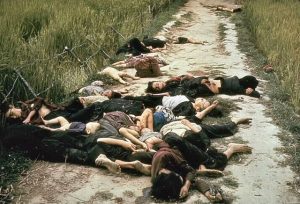
This photo was taken by United States Army photographer Ronald L. Haeberle on March 16, 1968, in the aftermath of the My Lai massacre showing mostly women and children dead on a road. Source: Wikimedia Commons
BATTLES AT HOME
As the conflict wore on and reports of brutalities increased, the antiwar movement grew in strength. To take the political pressure off himself and his administration and find a way to exit Vietnam “with honor,” Nixon began the process of Vietnamization, turning more responsibility for the war over to South Vietnamese forces by training them and providing American weaponry, while withdrawing U.S. troops from the field. At the same time, however, Nixon authorized the bombing of neighboring Cambodia, which had declared its neutrality, in an effort to destroy North Vietnamese and Viet Cong bases within that country and cut off supply routes between North and South Vietnam. The bombing was kept secret from both Congress and the American public. In April 1970, Nixon decided to follow up with an invasion of Cambodia.
When Nixon announced the invasion on television on April 13, 1970, protests sprang up across the country. The most tragic and politically damaging occurred on May 1, 1970, at Kent State University in Ohio. Violence erupted in the town of Kent after an initial student demonstration on campus, and the next day, the mayor asked Ohio’s governor to send in the National Guard. Troops were sent to the university’s campus, where students had set fire to the ROTC building and were fighting off firemen and policemen trying to extinguish it. The National Guard used teargas to break up the demonstration, and several students were arrested. Tensions came to a head on May 4. About fifteen hundred to two thousand students assembled, throwing rocks at a security officer who ordered them to leave. Seventy-seven members of the National Guard, with bayonets attached to their rifles, approached the students. For reasons that are still unknown, members of the guard fired at the students. Nine students were wounded; four were killed. Two of the dead had simply been crossing campus on their way to class.

On April 13, 1970, Richard Nixon announces plans for the Cambodia Campaign (a), provoking protests on college campuses across the country. Within days, the governor of Ohio had called in the National Guard in response to student demonstrations at Kent State University. Bill Whitbeck, who was a student majoring in photo illustration at Kent State University in May 1970, captured this image (b) on campus on May 3, one day before the shootings that would result in four student deaths. Source: Wikimedia Commons
News of the Kent State shootings shocked students around the country. Millions refused to attend class, as strikes were held at hundreds of colleges and high schools across the United States. On May 8, an antiwar protest took place in New York City, and the next day, 100,000 protesters assembled in Washington, DC. Not everyone sympathized with the slain students, however. Nixon had earlier referred to student demonstrators as “bums,” and construction workers attacked the New York City protestors. A Gallup poll revealed that most Americans blamed the students for the tragic events at Kent State.
On May 15, a similar tragedy took place at Jackson State College, an African American college in Jackson, Mississippi. Once again, students gathered on campus to protest the invasion of Cambodia, setting fires and throwing rocks. The police arrived to disperse the protesters, who had gathered outside a women’s dormitory. Shortly after midnight, the police opened fire with shotguns. The dormitory windows shattered, showering people with broken glass. Twelve were wounded, and two young men, one a student at the college and the other a local high school student, were killed.
PULLING OUT OF THE QUAGMIRE
Ongoing protests, campus violence, and the expansion of the war into Cambodia deeply disillusioned Americans about their role in Vietnam. Understanding the nation’s mood, Nixon dropped his opposition to a repeal of the Gulf of Tonkin Resolution of 1964. In January 1971, he signed Congress’s revocation of the notorious blanket military authorization. Gallup polls taken in May of that year revealed that only 28 percent of the respondents supported the war; many felt it was not only a mistake but also immoral.
Just as influential as antiwar protests and campus violence in turning people against the war was the publication of documents the media dubbed the Pentagon Papers in June 1971. These were excerpts from a study prepared during the Johnson administration that revealed that the American people had not been told the truth about the War. The public learned for the first time that Johnson meant to expand the U.S. role in Vietnam and bomb North Vietnam even as he stated publicly that he had no intentions of doing so, and that his administration had sought to deliberately provoke North Vietnamese attacks in order to justify escalating American involvement.
Realizing that he must end the war but reluctant to make it look as though the United States was admitting its failure to subdue a small Asian nation, Nixon began maneuvering to secure favorable peace terms from the North Vietnamese. Thanks to his diplomatic efforts in China and the Soviet Union, those two nations cautioned North Vietnam to use restraint. The loss of strong support by their patrons, together with intensive bombing of Hanoi and the mining of crucial North Vietnamese harbors by U.S. forces, made the North Vietnamese more willing to negotiate.
On January 27, 1973, Secretary of State Henry Kissinger signed an accord with Le Duc Tho, the chief negotiator for the North Vietnamese, ending American participation in the war. The war had cost the lives of more than 1.5 million Vietnamese combatants and civilians, as well as over 58,000 U.S. troops. But the war had caused another, more intangible casualty: the loss of consensus, confidence, and a sense of moral high ground in the American political culture.
13.3 Section Summary
As the war in Vietnam raged on, Americans were horrified to hear of atrocities committed by U.S. soldiers, such as the 1968 massacre of villagers at My Lai. To try to end the conflict, Nixon escalated it by bombing Hanoi and invading Cambodia; his actions provoked massive antiwar demonstrations in the United States that often ended in violence, such as the tragic shooting of unarmed student protestors at Kent State University in 1970. The 1971 release of the Pentagon Papers revealed the true nature of the war to an increasingly disapproving and disenchanted public. Secretary of State Henry Kissinger eventually drafted a peace treaty with North Vietnam, and, after handing over responsibility for the war to South Vietnam, the United States withdrew its troops in 1973. South Vietnam surrendered to the North two years later.
13.4 Watergate: Nixon’s Domestic Nightmare
Learning Objectives
By the end of this section, you will be able to:
- Describe the actions that Nixon and his confederates took to ensure his reelection in 1972
- Explain the significance of the Watergate crisis
- Describe Gerald Ford’s domestic policies and achievements in foreign affairs
Feeling the pressure of domestic antiwar sentiment and desiring a decisive victory, Nixon went into the 1972 reelection season having attempted to fashion a “new majority” of moderate southerners and northern, working-class whites. The Democrats, responding to the chaos and failings of the Chicago convention, had instituted new rules on how delegates were chosen, which they hoped would broaden participation and the appeal of the party. Nixon proved unbeatable, however. Even evidence that his administration had broken the law failed to keep him from winning the White House.
THE ELECTION OF 1972
In 1972, the Democrats chose George McGovern, a strong opponent of the Vietnam War, to be their nominee for President. Many Democrats refused to support his campaign, however. Working- and middle-class voters turned against him too after allegations that he supported women’s right to an abortion and the decriminalization of drug use.
Nixon and the Republicans led from the start. To increase their advantage, they attempted to paint McGovern as a radical leftist who favored amnesty for draft dodgers. In the Electoral College, McGovern carried only Massachusetts and Washington, DC. Nixon won a decisive victory of 520 electoral votes to McGovern’s 17.
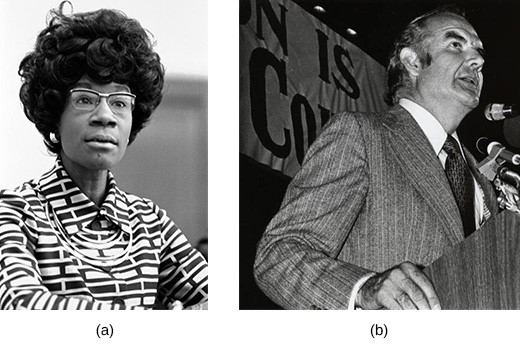
In November 1968, Shirley Chisholm (a) became the first African American woman to be elected to the House of Representatives. In January 1972, she announced her intention to run for the Democratic presidential nomination. The nomination eventually went to George McGovern (b), an outspoken opponent of the war in Vietnam. Source: Wikimedia Commons
HIGH CRIMES AND MISDEMEANORS
Nixon’s victory over a Democratic party in disarray was the most remarkable landslide since Franklin D. Roosevelt’s reelection in 1936. But Nixon’s victory was short-lived, however, for it was soon discovered that he and members of his administration had routinely engaged in unethical and illegal behavior during his first term.
During the presidential campaign, the Committee to Re-Elect the President (CREEP) decided to play “dirty tricks” on Nixon’s opponents. CREEP’s most notorious operation was its break-in at the offices of the Democratic National Committee (DNC) in the Watergate office complex in Washington, DC, as well as its subsequent coverup. On the evening of June 17, 1972, the police arrested five men inside DNC headquarters. According to a plan originally proposed by CREEP’s general counsel G. Gordon Liddy, the men were to wiretap DNC telephones.
In the weeks following the Watergate break-in, Bob Woodward and Carl Bernstein, reporters for The Washington Post, received information from several anonymous sources, including one known to them only as “Deep Throat,” that led them to realize the White House was deeply implicated in the break-in. As the press focused on other events, Woodward and Bernstein continued to dig and publish their findings, keeping the public’s attention on the unfolding scandal.
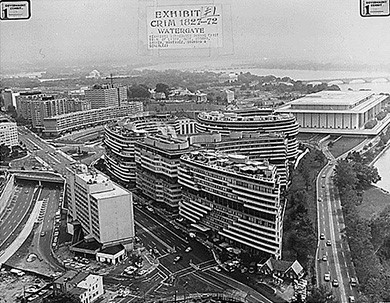
The Watergate hotel and office complex, located on the Potomac River next to the John F. Kennedy Center for the Performing Arts, was the scene of the 1972 burglary and attempted wiretapping that eventually brought down the presidency of Richard Nixon. Source: Wikimedia Commons
THE WATERGATE CRISIS
Initially, Nixon was able to hide his connection to the break-in and the other wrongdoings alleged against members of CREEP. However, by early 1973, the situation quickly began to unravel. In January, the Watergate burglars were convicted, along with Hunt and Liddy. Trial judge John Sirica was not convinced that all the guilty had been discovered. In February, confronted with evidence that people close to the president were connected to the burglary, the Senate appointed the Watergate Committee to investigate. Ten days later, in his testimony before the Senate Judiciary Committee, L. Patrick Gray, acting director of the FBI, admitted destroying evidence taken from Hunt’s safe by John Dean, the White House counsel, after the burglars were caught.
Throughout the spring and the long, hot summer of 1973, Americans sat glued to their television screens, as the major networks took turns broadcasting the Senate hearings. One by one, disgraced former members of the administration confessed, or denied, their role in the Watergate scandal. Dean testified that Nixon was involved in the conspiracy, allegations the president denied. In March 1974, Haldeman, Ehrlichman, and Mitchell were indicted and charged with conspiracy. Without evidence clearly implicating the president, the investigation might have ended if not for the testimony of Alexander Butterfield, a low-ranking member of the administration, that a voice-activated recording system had been installed in the Oval Office. The President’s most intimate conversations had been caught on tape. Archibald Cox who had been appointed Special Prosecutor by the Attorney General to investigate the affair subpoenaed them.
Nixon, however, refused to hand the tapes over and cited executive privilege, the right of the president to refuse certain subpoenas. When he offered to supply summaries of the conversations, Cox refused. On October 20, 1973, in an event that became known as the Saturday Night Massacre, Nixon ordered Attorney General Richardson to fire Cox. Richardson refused and resigned, as did Deputy Attorney General William Ruckelshaus when confronted with the same order. Control of the Justice Department then fell to Solicitor General Robert Bork, who complied with Nixon’s order. In December, the House Judiciary Committee began its own investigation to determine whether there was enough evidence of wrongdoing to impeach the president.
The public was enraged by Nixon’s actions. It seemed as though the president had placed himself above the law. Telegrams flooded the White House. The House of Representatives began to discuss impeachment. At the end of its hearings, in July 1974, the House Judiciary Committee voted to impeach. However, before the full House could vote, the U.S. Supreme Court ordered Nixon to release the actual tapes of his conversations, not just transcripts or summaries. One of the tapes revealed that he had in fact been told about White House involvement in the Watergate break-in shortly after it occurred. In a speech on August 5, 1974, Nixon, pleading a poor memory, accepted blame for the Watergate scandal. Warned by other Republicans that he would be found guilty by the Senate and removed from office, he resigned the presidency on August 8.
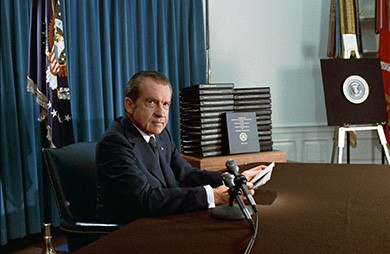
In April 1974, President Richard Nixon prepares to address the nation to clarify his position on releasing the White House tapes. Source: Wikimedia Commons
Nixon’s resignation, which took effect the next day, did not make the Watergate scandal vanish. Instead, it fed a growing suspicion of government felt by many. The events of Vietnam had already showed that the government could not be trusted to protect the interests of the people or tell them the truth. For many, Watergate confirmed these beliefs, and the suffix “-gate” attached to a word has since come to mean a political scandal.
FORD NOT A LINCOLN
When Gerald R. Ford took the oath of office on August 9, 1974, he understood that his most pressing task was to help the country move beyond the Watergate scandal. It was indeed an unprecedented time. Ford was the first vice president to take office after a sitting president’s resignation. One of his first actions as president was to grant Richard Nixon a full pardon. Ford thus prevented Nixon’s indictment for any crimes he may have committed in office and ended criminal investigations into his actions. The public reacted with suspicion and outrage. Many were convinced that the extent of Nixon’s wrongdoings would now never been known, and he would never be called to account for them. When Ford chose to run for the presidency in 1976, the pardon returned to haunt him.
As president, Ford confronted monumental issues, such as inflation, a depressed economy, and chronic energy shortages. He established his policies during his first year in office, despite opposition from a heavily Democratic Congress. Ford’s economic policies ultimately proved unsuccessful. Because of opposition from a Democratic Congress, his foreign policy accomplishments were also limited. When he requested money to assist the South Vietnamese government in its effort to repel North Vietnamese forces, Congress refused. Ford was more successful in other parts of the world. He continued Nixon’s policy of détente with the Soviet Union. In August 1975, Ford went to Finland and signed the Helsinki Accords with Soviet premier Leonid Brezhnev. This agreement essentially accepted the territorial boundaries that had been established at the end of World War II in 1945. It also exacted a pledge from the signatory nations that they would protect human rights within their countries. Many immigrants to the United States protested Ford’s actions, because it seemed as though he had accepted the status quo and left their homelands under Soviet domination. Others considered it a belated American acceptance of the world as it really was.
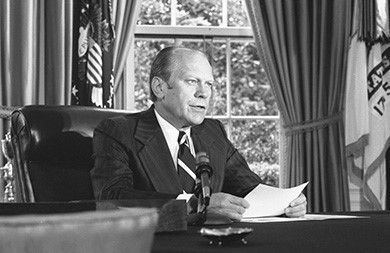
In one of his first actions as president, Gerald R. Ford announced a full pardon for Richard Nixon on September 8, 1974. Nixon had appointed Ford vice president after the resignation of Spiro Agnew. Source: Wikimedia Commons
13.4 Section Summary
In 1972, President Nixon faced an easy reelection against a Democratic Party in disarray. But even before his landslide victory, evidence had surfaced that the White House was involved in the break-in at the DNC’s headquarters at the Watergate office complex. As the investigation unfolded, the depths to which Nixon and his advisers had sunk became clear. Some twenty-five of Nixon’s aides were indicted for criminal activity, and he became the first president impeached since Andrew Johnson and the first to resign from office. His successor, Gerald Ford, was unable to solve the pressing problems the United States faced or erase the stain of Watergate.
13.5 Jimmy Carter in the Aftermath of the Storm
Learning Objectives
By the end of this section, you will be able to:
- Explain why Gerald Ford lost the election of 1976
- Describe Jimmy Carter’s domestic and foreign policy achievements
- Discuss how the Iranian hostage crisis affected the Carter presidency
At his inauguration in January 1977, President Jimmy Carter began his speech by thanking outgoing president Gerald Ford for all he had done to “heal” the scars left by Watergate. American gratitude had not been great enough to return Ford to the Oval Office, but enthusiasm for the new president was not much greater in the new atmosphere of disillusionment with political leaders. Ultimately, Carter’s presidency proved a lackluster one that was marked by economic stagnation at home and humiliation overseas.
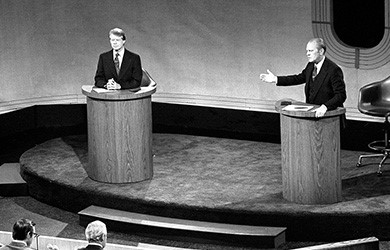
President Gerald Ford (right) and Democratic challenger Jimmy Carter dueled in Philadelphia in 1976, during the first televised presidential debate since that between Richard Nixon and John F. Kennedy in 1960. Source: Wikimedia Commons
THE ELECTION OF 1976
President Ford won the Republican nomination for the presidency in 1976, narrowly defeating former California governor Ronald Reagan, but he lost the election to his Democratic opponent Jimmy Carter. Carter ran on an “anti-Washington” ticket, making a virtue of his lack of experience in what was increasingly seen as the corrupt politics of the nation’s capital. Accepting his party’s nomination, the former governor of Georgia pledged to combat racism and sexism as well as overhaul the tax structure. He openly proclaimed his faith as a born-again Christian and promised to change the welfare system and provide comprehensive healthcare coverage for neglected citizens who deserved compassion. Ford did well in the West, but Carter received 50 percent of the popular vote to Ford’s 48 percent, and 297 electoral votes to Ford’s 240.
ON THE INSIDE
Making a virtue of his lack of political experience, especially in Washington, Jimmy Carter took office with less practical experience in executive leadership and the workings of the national government than any president since Calvin Coolidge. His first executive act was to fulfill a campaign pledge to grant unconditional amnesty to young men who had evaded the draft during the Vietnam War. In trying to manage the relatively high unemployment rate of 7.5 percent and inflation that had risen into the double digits by 1978, Carter was only marginally effective. He also expanded various social programs, improved housing for the elderly, and took steps to improve workplace safety. Because the high cost of fuel continued to hinder economic expansion, the creation of an energy program became a central focus of his administration. Carter stressed energy conservation, encouraging people to insulate their houses and rewarding them with tax credits if they did so, and pushing for the use of coal, nuclear power, and alternative energy sources such as solar power to replace oil and natural gas.
CARTER AND A NEW DIRECTION IN FOREIGN AFFAIRS
Carter believed that U.S. foreign policy should be founded upon deeply held moral principles and national values. The mission in Vietnam had failed, he argued, because American actions there were contrary to moral values. His dedication to peace and human rights significantly changed the way that the United States conducted its foreign affairs. Despite achieving many successes in the area of foreign policy, Carter made a more controversial decision in response to the Soviet Union’s 1979 invasion of Afghanistan. In January 1980, he declared that if the USSR did not withdraw its forces, the United States would boycott the 1980 Summer Olympic Games in Moscow. The Soviets did not retreat, and the United States did not send a team to Moscow. Only about half of the American public supported this decision, and despite Carter’s call for other countries to join the boycott, very few did so.
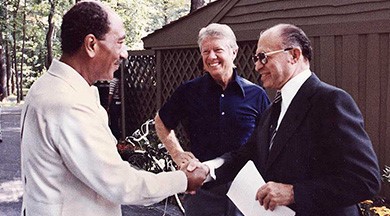
President Jimmy Carter meets with Egypt’s Anwar Sadat (left) and Israel’s Menachem Begin (right) at Camp David in 1978. Sadat was assassinated in 1981, partly because of his willingness to make peace with Israel. Source: Wikimedia Commons
HOSTAGES TO HISTORY
Carter’s biggest foreign policy problem was the Iranian hostage crisis, whose roots lay in the 1950s. In 1953, the United States had assisted Great Britain in the overthrow of Prime Minister Mohammad Mossadegh, a rival of Mohammad Reza Pahlavi, the shah of Iran. Following the coup, the shah assumed complete control of Iran’s government. He then disposed of political enemies and eliminated dissent through the use of SAVAK, a secret police force trained by the United States. Iranians increasingly blamed the United States for the death of Iranian democracy and faulted it for its consistent support of Israel.
Despite the shah’s unpopularity among his own people, the result of both his brutal policies and his desire to Westernize Iran, the United States supported his regime. In February 1979, the shah was overthrown when revolution broke out, and a few months later, he departed for the United States for medical treatment. The long history of U.S. support for him and its offer of refuge greatly angered Iranian revolutionaries. On November 4, 1979, a group of Iranian students and activists, including Islamic fundamentalists who wished to end the Westernization and secularization of Iran, invaded the American embassy in Tehran and seized sixty-six embassy employees. The women and African Americans were soon released, leaving fifty-three men as hostages. Negotiations failed to free them, and in April 1980, a rescue attempt fell through when the aircraft sent to transport them crashed. President Carter’s inability to free the other captives hurt his performance in the 1980 elections. The fifty-two men still held in Iran were finally freed on January 20, 1981, the day Ronald Reagan took office as president.
Carter’s handling of the crisis appeared even less effective in the way the media portrayed it publicly. This contributed to a growing sense of malaise, a feeling that the United States’ best days were behind it and the country had entered a period of decline. Carter had failed to solve the nation’s problems. Some blamed these problems on dishonest politicians; others blamed the problems on the Cold War obsession with fighting Communism, even in small nations like Vietnam that had little influence on American national interests. Still others faulted American materialism. In 1980, a small but growing group called the Moral Majority faulted Carter for betraying his southern roots and began to seek a return to traditional values.
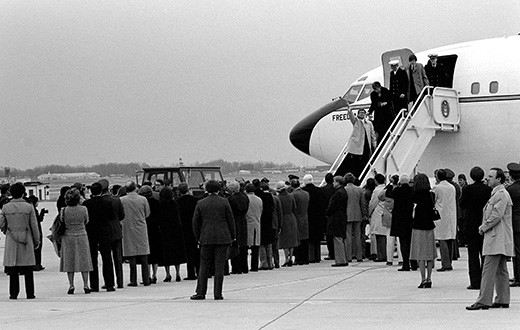
The fifty-two American hostages return from Iran in January 1981. They had been held for 444 days. Source: Wikimedia Commons
13.5 Section Summary
Jimmy Carter’s administration began with great promise, but his efforts to improve the economy through deregulation largely failed. Carter’s attempt at a foreign policy built on the principle of human rights also prompted much criticism, as did his decision to boycott the Summer Olympics in Moscow. On the other hand, he successfully brokered the beginnings of a historic peace treaty between Egypt and Israel. Remaining public faith in Carter was dealt a serious blow, however, when he proved unable to free the American hostages in Tehran.
13.6 The Reagan Revolution
Learning Objectives
By the end of this section, you will be able to:
- Explain Ronald Reagan’s attitude towards government
- Discuss the Reagan administration’s economic policies and their effects on the nation
Ronald Reagan entered the White House in 1981 with strongly conservative values but experience in moderate politics. He appealed to moderates and conservatives anxious about social change and the seeming loss of American power and influence on the world stage. Leading the so-called Reagan Revolution, he appealed to voters with the promise that the principles of conservatism could halt and revert the social and economic changes of the last generation. Reagan won the White House by citing big government and attempts at social reform as the problem, not the solution. He was able to capture the political capital of an unsettled national mood and, in the process, helped set an agenda and policies that would affect his successors and the political landscape of the nation.
REAGAN’S EARLY CAREER
Reagan’s rise to the presidency was an unusual transition from pop cultural significance to political success. Born and raised in the Midwest, he moved to California in 1937 to become a Hollywood actor. He rose to leadership in the Screen Actors Guild, a Hollywood union; and became a spokesman for General Electric and the host of a television series that the company sponsored. As a young man, he identified politically as a liberal Democrat, but his distaste for communism, along with the influence of the social conservative values of his second wife, actress Nancy Davis, edged him closer to conservative Republicanism. By 1962, he had formally switched political parties, and in 1964, he actively campaigned for the Republican presidential nominee Barry Goldwater.
Reagan launched his own political career in 1966 when he successfully ran for governor of California. As governor, however, he quickly learned that federal and state laws prohibited the elimination of certain programs and that many programs benefited his constituents. He ended up approving the largest budget in the state’s history and approved tax increases on a number of occasions. The contrast between Reagan’s rhetoric and practice made up his political skill: capturing the public mood and catering to it but compromising when necessary.
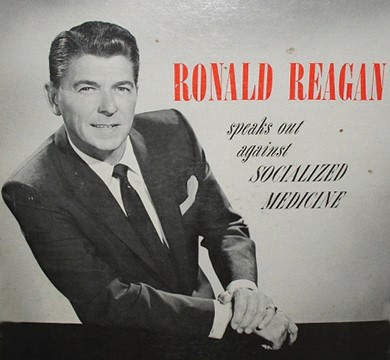
In 1961, Reagan made a recording for the American Medical Association in which he denounced the idea of healthcare for all—which was later adopted as Medicare—as “socialized medicine.” Such a program, Reagan warned his listeners, was the first step to the nation’s demise as a free society. Source: Wikimedia Commons
REPUBLICANS BACK IN THE WHITE HOUSE
After two unsuccessful Republican primary bids in 1968 and 1976, Reagan won the presidency in 1980. His victory was the result of a combination of dissatisfaction with the presidential leadership of Gerald Ford and Jimmy Carter in the 1970s and the growth of the New Right. This group of conservative Americans included many very wealthy financial supporters and emerged in the wake of the social reforms and cultural changes of the 1960s and 1970s.
Many were evangelical Christians, like those who joined Jerry Falwell’s Moral Majority, and opposed the legalization of abortion, the feminist movement, and sex education in public schools. Reagan also attracted people, often dubbed neoconservatives, who would not previously have voted for the same candidate as conservative Protestants. Many were middle and working-class people who resented the growth of federal and state governments, especially benefit programs, and the subsequent increase in taxes during the late 1960s and 1970s. They favored the tax revolts that swept the nation in the late 1970s under the leadership of predominantly older, white, middleclass Americans, which had succeeded in imposing radical reductions in local property and state income taxes.
Voter turnout reflected this new conservative swing, which not only swept Reagan into the White House but created a Republican majority in the Senate. Only 52 percent of eligible voters went to the polls in 1980, the lowest turnout for a presidential election since 1948. Those who did cast a ballot were older, whiter, and wealthier than those who did not vote.
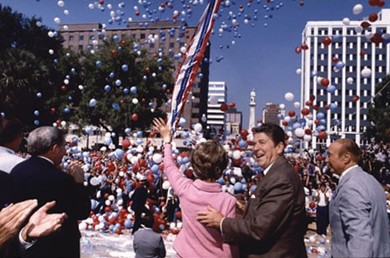
Ronald Reagan campaigns for the presidency with his wife Nancy in South Carolina in 1980. Reagan won in all the Deep South states except Georgia, although he did not come from the South and his opponent Jimmy Carter did. Source: Wikimedia Commons
REAGANOMICS
Reagan’s primary goal upon taking office was to stimulate the sagging economy while simultaneously cutting both government programs and taxes. His economic policies, called Reaganomics by the press, were based on a theory called supply-side economics. Proponents of “trickledown economics” (as it was also called) promised to cut taxes and balance the budget at the same time. Reaganomics also included the deregulation of industry and higher interest rates to control inflation, but these initiatives preceded Reagan and were conceived in the Carter administration.
Many politicians, including Republicans, were wary of Reagan’s economic program; even his eventual vice president, George H. W. Bush, had referred to it as “voodoo economics” when competing with him for the Republican presidential nomination. When Reagan proposed a 13 percent cut in taxes to be phased in over his first term in office, Congress balked. Opponents argued that the tax cuts would benefit the rich and not the poor, who needed help the most. In response, Reagan presented his plan directly to the people.
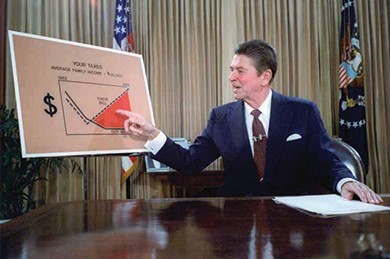
Ronald Reagan outlines his plan for tax reduction legislation in July 1981. Data suggest that the supply side policies of the 1980s actually produced less investment, slightly slower growth, and a greater decline in wages than the non–supply side policies of the 1990s. Source: Wikimedia Commons.
Reagan was an articulate spokesman for his political perspectives and was able to garner support for his policies. Often called “The Great Communicator,” he was noted for his ability, honed through years as an actor and spokesperson, to convey a mixture of folksy wisdom, empathy, and concern while taking humorous digs at his opponents. Indeed, listening to Reagan speak often felt like hearing a favorite uncle recall stories about the “good old days” before big government, expensive social programs, and greedy politicians destroyed the country. Americans found this rhetorical style extremely compelling. Public support for the plan, combined with a surge in the president’s popularity after he survived an assassination attempt in March 1981, swayed Congress, including many Democrats. On July 29, 1981, Congress passed the Economic Recovery Tax Act, which phased in a 25 percent overall reduction in taxes over a period of three years.
Reagan was successful at cutting taxes, but he failed to reduce government spending. Although he had long warned about the dangers of big government, he created a new cabinet-level agency, the Department of Veterans Affairs, and the number of federal employees increased during his time in office. He allocated a smaller share of the federal budget to antipoverty programs like Aid to Families with Dependent Children (AFDC), food stamps, rent subsidies, job training programs, and Medicaid, but Social Security and Medicare entitlements, from which his supporters benefited, were left largely untouched except for an increase in payroll taxes to pay for them.
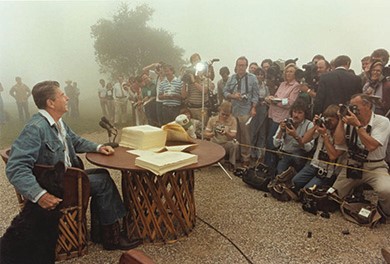
President Ronald Reagan signs economic reform legislation at his ranch in California. Note the blue jeans, denim jacket, and cowboy boots he wears. Source: Wikimedia Commons
But Reagan seemed less flexible when it came to deregulating industry and weakening the power of labor unions. Banks and savings and loan associations were deregulated. Pollution control was enforced less strictly by the Environmental Protection Agency, and restrictions on logging and drilling for oil on public lands were relaxed. Believing the free market was self-regulating, the Reagan administration had little use for labor unions, and in 1981, the president fired twelve thousand federal air traffic controllers who had gone on strike to secure better working conditions (which would also have improved the public’s safety). His action effectively destroyed the Professional Air Traffic Controllers Organization (PATCO) and ushered in a new era of labor relations in which, following his example, employers simply replaced striking workers. The weakening of unions contributed to the leveling off of real wages for the average American family during the 1980s.
Reagan’s economic policymakers succeeded in breaking the cycle of stagflation that had been plaguing the nation, but at significant cost. In its effort to curb high inflation with dramatically increased interest rates, the Federal Reserve also triggered a deep recession. Inflation did drop but borrowing became expensive and consumers spent less. In Reagan’s first years in office, bankruptcies increased, and unemployment reached about 10 percent, its highest level since the Great Depression. Homelessness became a significant problem in cities, a fact the president made light of by suggesting that the press exaggerated the problem and that many homeless people chose to live on the streets. Economic growth resumed in 1983 and gross domestic product grew at an average of 4.5 percent during the rest of his presidency. By the end of Reagan’s second term in office, unemployment had dropped to about 5.3 percent, but the nation was nearly $3 trillion in debt. An increase in defense spending coupled with $3.6 billion in tax relief for the 162,000 American families with incomes of $200,000 or more made a balanced budget, one of the president’s campaign promises in 1980, impossible to achieve.
The Reagan years were a complicated era of social, economic, and political change, with many trends operating simultaneously and sometimes at cross-purposes. While many suffered, others prospered. The 1970s had been the era of the hippie, and Newsweek magazine declared 1984 to be the “year of the Yuppie.” Yuppies, whose name derived from “(y)oung, (u)rban (p)rofessionals,” were akin to hippies in being young people whose interests, values, and lifestyle influenced American culture, economy, and politics, just as the hippies’ credo had done in the late 1960s and 1970s. Unlike hippies, however, yuppies were materialistic and obsessed with image, comfort, and economic prosperity. Although liberal on some social issues, economically they were conservative. Ironically, some yuppies were former hippies or yippies, like Jerry Rubin, who gave up his crusade against “the establishment” to become a businessman.
13.6 Section Summary
After decades of liberalism and social reform, Ronald Reagan changed the face of American politics by riding a groundswell of conservatism into the White House. Reagan’s superior rhetorical skills enabled him to gain widespread support for his plans for the nation. Implementing a series of economic policies dubbed “Reaganomics,” the president sought to stimulate the economy while shrinking the size of the federal government and providing relief for the nation’s wealthiest taxpayers. During his two terms in office, he cut spending on social programs, while increasing spending on defense. While Reagan was able to break the cycle of stagflation, his policies also triggered a recession, plunged the nation into a brief period of significant unemployment, and made a balanced budget impossible. In the end, Reagan’s policies diminished many Americans’ quality of life while enabling more affluent Americans—the “Yuppies” of the 1980s—to prosper.
13.7 Political and Cultural Fusions
Learning Objectives
By the end of this section, you will be able to:
- Discuss the culture wars and political conflicts of the Reagan era
- Describe the Religious Right’s response to the issues of the Reagan era
Ronald Reagan’s victory in 1980 suggested to conservatives that the days of liberalism were over, and the liberal establishment might be dismantled. Many looked forward to the discontinuation of policies like affirmative action. Conservative Christians sought to outlaw abortion and stop the movement for gay and lesbian rights. Republicans, and some moderate Democrats, demanded a return to “traditional” family values, a rhetorical ploy to suggest that male authority over women and children constituted a natural order that women’s rights and the New Left had subverted since the 1960s. As the conservative message regarding the evils of government permeated society, distrust of the federal government grew, inspiring some to form organizations and communities that sought complete freedom from government control.
CREATING CONSERVATIVE POLICY
Ronald Reagan’s popularity and effectiveness as a leader drew from his reputation as a man who fought for what he believed in. He was a very articulate spokesperson for a variety of political ideas based on conservative principles and perspectives. Much of the intellectual meat of the Reagan Revolution came from conservative think tanks (policy or advocacy groups) that specifically sought to shape American political and social dialogues. The Heritage Foundation, one such group, soon became the intellectual arm of the conservative movement. The foundation had lent considerable support and encouragement to the conservative dialogues that helped carry Ronald Reagan into office in 1980. Just a year later, it produced a document entitled Mandate for Leadership that catalogued some two thousand specific recommendations on how to shrink the size and reach of the federal government and implement a more consistent conservative agenda. The newly elected Reagan administration looked favorably on the recommendations and recruited several of the paper’s authors to serve in the White House.
CONSERVATIVE CHRISTIANS AND FAMILY VALUES
Among the strongest supporters of Ronald Reagan’s campaign for president were members of the Religious Right, including Christian groups like the Moral Majority, 61 percent of whom voted for him. By 1980, evangelical Christians had become an important political and social force in the United States. Some thirteen hundred radio stations in the country were owned and operated by evangelicals. Christian television programs, such as Pat Robertson’s The 700 Club and Jim Bakker’s The PTL (Praise the Lord) Club, proved enormously popular and raised millions of dollars from viewer contributions. Most conservative Christians were true believers who were convinced that premarital and extramarital sex, abortion, drug use, homosexuality, and “irreligious” forms of popular and high culture were responsible for a perceived decline in traditional family values that threatened American society.
Despite the support he received from Christian conservative and family values voters, Reagan was hardly an ideologue when it came to policy. Indeed, he was often quite careful in using hot button, family-value issues to his greatest political advantage. For example, as governor of California, one of the states that ratified the Equal Rights Amendment (ERA) in its first year, he positioned himself as a supporter of the amendment. When he launched his bid for the Republican nomination in 1976, however, he withdrew his support to gain the backing of more conservative members of his party. This move demonstrated both political savvy and foresight. At the time he withdrew his support, the Republican National Convention was still officially backing the amendment. However, in 1980, the party began to qualify its stance, which dovetailed with Reagan’s candidacy for the White House. Reagan stated that the Fourteenth Amendment to the Constitution was sufficient protection for women against discrimination. Once in office, he took a mostly neutral position, neither supporting nor working against the ERA.
|
|
DEFINING “AMERICAN” |
|
Phyllis Schlafly and the STOP ERA Movement In 1972, after a large number of states jumped to ratify the Equal Rights Amendment, most observers believed its ultimate ratification by all the necessary states was all but certain. But, a decade later, the amendment died without ever getting the necessary votes. There are many reasons it went down in defeat, but a major one was Phyllis Schlafly. On the surface, Schlafly’s life might suggest that she would naturally support the ERA. After all, she was a well-educated, professional woman who sought advancement in her field and even aspired to high political office. Yet she is a fascinating historical character, precisely because her life and goals don’t conform to expected norms. Schlafly’s attack on the ERA was ingenious in its method and effectiveness. Rather than attacking the amendment directly as a gateway to unrestrained and immoral behavior as some had, she couched her opposition in language that was sensitive to both privilege and class. Her instrument was the STOP ERA movement, with the acronym STOP, standing for “Stop Taking our Privileges.” Schlafly argued that women enjoyed special privileges such as gender-specific restrooms and exemption from the military draft. These, she claimed, would be lost should the ERA be ratified. But she also claimed to stand up for the dignity of being a homemaker and lambasted the feminist movement as elitist. In this, she was keenly aware of the power of class interests. Her organization suggested that privileged women could afford to support the ERA. Working women and poor housewives, however, would ultimately bear the brunt of the loss of protection it would bring. In the end, her tactics were successful in achieving exactly what the movement’s name suggested; she stopped the ERA. |
|
Reagan’s political calculations notwithstanding, his belief that traditional values were threatened by a modern wave of immoral popular culture was genuine. He recognized that nostalgia was a powerful force in politics, and he drew a picture for his audiences of the traditional good old days under attack by immorality and decline. This middle position did not appear to hurt him at the polls; he attracted a significant number of votes from women in 1980, and in 1984, he polled 56 percent of the women’s vote compared to 44 percent for the Democratic ticket of Walter Mondale and Geraldine Ferraro, the first female candidate for vice president from a major party.
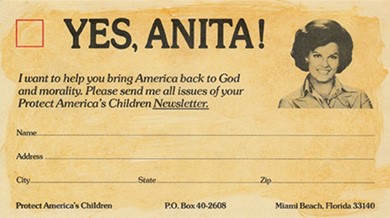
This fundraising card was used by Anita Bryant, singer, and beauty pageant winner, to gather support for Save Our Children Inc., a political coalition she formed in the late 1970s to overturn a Florida ordinance banning discrimination based on sexual orientation. Many of the group’s strategies were soon embraced by the Moral Majority. Source: Wikimedia Commons
THE AIDS CRISIS
In the early 1980s, doctors noticed a disturbing trend: Young gay men in large cities, especially San Francisco and New York, were being diagnosed with, and eventually dying from, a rare cancer called Kaposi’s sarcoma. Because the disease was seen almost exclusively in male homosexuals, it was quickly dubbed “gay cancer.” Doctors soon realized it often coincided with other symptoms, including a rare form of pneumonia, and they renamed it “Gay Related Immune Deficiency” (GRID), although people other than gay men, primarily intravenous drug users, were dying from the disease as well. The connection between gay men and GRID—later renamed human immunodeficiency virus/autoimmune deficiency syndrome, or HIV/AIDS—led heterosexuals largely to ignore the growing health crisis in the gay community, wrongly assuming they were safe from its effects. The federal government also overlooked the disease, and calls for more money to research and find the cure were ignored.
Even after it became apparent that heterosexuals could contract the disease through blood transfusions and heterosexual intercourse, HIV/AIDS continued to be associated primarily with the gay community, especially by political and religious conservatives. Indeed, the Religious Right regarded it as a form of divine retribution meant to punish gay men for their “immoral” lifestyle. President Reagan, always politically careful, was reluctant to speak openly about the developing crisis even as thousands faced certain death from the disease.
With little help coming from the government, the gay community quickly began to organize its own response. In 1982, New York City men formed the Gay Men’s Health Crisis (GMHC), a volunteer organization that operated an information hotline, provided counseling and legal assistance, and raised money for people with HIV/AIDS. Larry Kramer, one of the original members, left in 1983 and formed his own organization, the AIDS Coalition to Unleash Power (ACT UP), in 1987. ACT UP took a more militant approach, holding demonstrations on Wall Street, outside the U.S. Food and Drug Administration (FDA), and inside the New York Stock Exchange to call attention and shame the government into action.
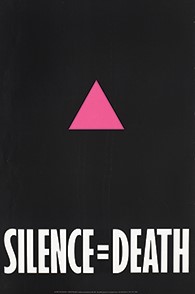
The pink triangle was originally used in Nazi concentration camps to identify those there for acts of homosexuality. Reclaimed by gay activists in New York as a symbol of resistance and solidarity during the 1970s, it was further transformed as a symbol of governmental inaction in the face of the AIDS epidemic during the 1980s. Source: Wikimedia Commons
THE WAR ON DRUGS AND THE ROAD TO MASS INCARCERATION
As Ronald Reagan took office in 1981, violent crime in the United States was reaching an all-time high. While there were different reasons for the spike, the most important one was demographics: The primary category of offenders, males between the ages of sixteen and thirty-six, reached an all-time peak as the baby-boomer generation came of age. But the phenomenon that most politicians concentrated on as a cause for violent crime was the abuse of a new, cheap drug dealt illegally on city streets. Crack cocaine, a smokable type of cocaine popular with poorer addicts, was hitting the streets in the 1980s, frightening middle-class Americans. Reagan and other conservatives led a campaign to “get tough on crime” and promised the nation a “war on drugs.” Initiatives like the “Just Say No” campaign led by First Lady Nancy Reagan implied that drug addiction and drug-related crime reflected personal morality.
Nixon had first used the term in 1971, but in the 1980s the “war on drugs” took on an ominous dimension, as politicians scrambled over each other to enact harsher sentences for drug offenses so they could market themselves as tough on crime. State after state switched from variable to mandatory minimum sentences that were exceedingly long and particularly harsh for street drug crimes. The federal government supported the trend with federal sentencing guidelines and additional funds for local law enforcement agencies. This law-and-order movement peaked in the 1990s, when California introduced a “three strikes” law that mandated life imprisonment without parole for any third felony conviction—even nonviolent ones. As a result of this new emphasis, prisons became crowded, and states went deep into debt to build more. By the end of the century, the war began to die down as the public lost interest in the problem, the costs of the punishment binge became politically burdensome, and scholars and politicians began to advocate the decriminalization of drug use. By this time, however, hundreds of thousands of people had been incarcerated for drug offenses and the total number of prisoners in the nation had grown four-fold in the last quarter of the century. Particularly glaring were the racial inequities of the new age of mass incarceration, with African Americans being seven times more likely to be in prison.
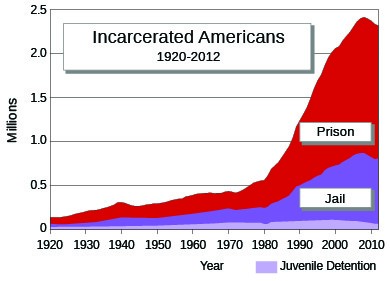
This graph of the number of people in jail, prison, and juvenile detention by decade in the United States shows the huge increase in incarceration during the war on drugs that began in the 1980s, during the Reagan administration. (Prisons are long-term state or federal facilities; jails are local, short-term facilities.) Source: Wikimedia Commons
13.7 Section Summary
The political conservatism of the 1980s and 1990s was matched by the social conservatism of the period. Conservative politicians wished to limit the size and curb the power of the federal government. Conservative think tanks flourished, the Christian Right defeated the ERA, and bipartisan efforts to add warning labels to explicit music lyrics were the subject of Congressional hearings. HIV/AIDS, which became chiefly and inaccurately associated with the gay community, grew to crisis proportions, as heterosexuals and the federal government failed to act. In response, gay men organized advocacy groups to fight for research on HIV/AIDS. Meanwhile, the so-called war on drugs began a get-tough trend in law enforcement that mandated lengthy sentences for drug-related offenses and hugely increased the American prison population.
13.8 A New American Order
Learning Objectives
By the end of this section, you will be able to:
- Describe the successes and failures of Ronald Reagan’s foreign policy
- Compare the policies of Ronald Reagan with those of George H. W. Bush
- Explain the causes and results of the Persian Gulf War
In addition to reviving the economy and reducing the size of the federal government, Ronald Reagan also wished to restore American stature in the world. He entered the White House a “cold warrior” and referred to the Soviet Union in a 1983 speech as an “evil empire.” Dedicated to upholding even authoritarian governments in foreign countries to keep them safe from Soviet influence, he was also desperate to put to rest Vietnam Syndrome, the reluctance to use military force in foreign countries for fear of embarrassing defeat, which had influenced U.S. foreign policy since the mid-1970s.
THE MIDDLE EAST AND CENTRAL AMERICA
Reagan’s desire to demonstrate U.S. readiness to use military force abroad sometimes had tragic consequences. In 1983, he sent soldiers to Lebanon as part of a multinational force trying to restore order following an Israeli invasion the year before. On October 23, more than two hundred troops were killed in a barracks bombing in Beirut carried out by Iranian-trained militants known as Hezbollah.

The suicide bombing of the U.S. Embassy in Beirut on April 18, 1983, marked the first of a number of attacks on U.S. targets in the region. Source: Wikimedia Commons
Two days after the bombing in Beirut, Reagan and Secretary of State George P. Shultz authorized the invasion of Grenada, a small Caribbean Island nation, in an attempt to oust a Communist military junta that had overthrown a moderate regime. Communist Cuba already had troops and technical aid workers stationed on the island and were willing to defend the new regime, but the United States swiftly took command of the situation, and the Cuban soldiers surrendered after two days. Reagan’s intervention in Grenada was intended to send a message to Marxists in Central America.
A similar message was sent to Nicaragua which was governed by a largely Marxist-inspired group, the Sandinistas. A year into his presidency, convinced it was folly to allow the expansion of Soviet and Communist influence in Latin America, Reagan authorized the Central Intelligence Agency (CIA) to equip and train a group of anti-Sandinista Nicaraguans known as the Contras (contrarevolucionários or “counter-revolutionaries”) to oust Ortega. Reagan’s National Security Council aide, Lieutenant Colonel Oliver North, found a way to sell weapons to Iran and secretly use the proceeds to support the Nicaraguan Contras—in direct violation of a congressional ban on military aid to the anti-Communist guerillas in that Central American nation. Eventually the Senate became aware, and North and others were indicted on various charges, which were all dismissed, overturned on appeal, or granted presidential pardon. Reagan, known for delegating much authority to subordinates and unable to “remember” crucial facts and meetings, escaped the scandal with nothing more than criticism for his lax oversight.
THE COLD WAR WAXES AND WANES
While trying to shrink the federal budget and the size of government sphere at home, Reagan led an unprecedented military buildup in which money flowed to the Pentagon to pay for expensive new forms of weaponry. One of the most controversial aspects of Reagan’s plan was the Strategic Defense Initiative (SDI), which he proposed in 1983. SDI, or “Star Wars,” called for the development of a defensive shield to protect the United States from a Soviet missile strike. The system was never built, and the plan, estimated to have cost some $7.5 billion, was finally abandoned.
Anticipating his reelection campaign in 1984, Reagan began to moderate his position toward the Soviet Union, largely at the initiative of his new counterpart, Mikhail Gorbachev. The new and comparatively young Soviet premier did not want to commit additional funds for another arms race, especially since the war in Afghanistan against mujahedeen—Islamic guerilla fighters—had depleted the Soviet Union’s resources severely since its invasion of the central Asian nation in 1979. Gorbachev recognized that economic despair at home could easily result in larger political upheavals like those in neighboring Poland, where the Solidarity movement had taken hold. He withdrew troops from Afghanistan, introduced political reforms and new civil liberties at home—known as perestroika and glasnost—and proposed arms reduction talks with the United States.
In 1985, Gorbachev and Reagan met in Geneva to reduce armaments and shrink their respective military budgets. The following year, meeting in Reykjavík, Iceland, they surprised the world by announcing that they would try to eliminate nuclear weapons by 1996. In 1987, they agreed to eliminate a whole category of nuclear weapons when they signed the Intermediate-Range Nuclear Forces (INF) Treaty at the White House. This laid the foundation for future agreements limiting nuclear weapons.
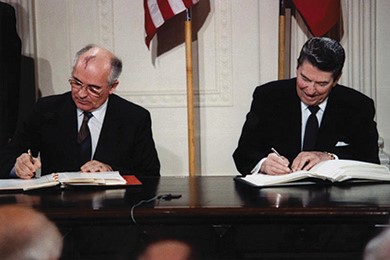
In the East Room of the White House, President Reagan and Soviet general secretary Mikhail Gorbachev sign the 1987 INF Treaty, eliminating one category of nuclear weapons. Source: Wikimedia Commons
“NO NEW TAXES”
In 1988, confident they could win back the White House, Democrats mounted a campaign focused on more effective and competent government under the leadership of Massachusetts governor Michael Dukakis. When George H. W. Bush, Reagan’s vice president and Republican nominee, found himself down in the polls, political advisor Lee Atwater launched an aggressively negative media campaign, accusing Dukakis of being soft on crime and connecting his liberal policies to a brutal murder in Massachusetts. More importantly, Bush adopted a largely Reaganesque style on matters of economic policy, promising to shrink government and keep taxes low. These tactics were successful, and the Republican Party retained the White House.
Although he promised to carry on Reagan’s economic legacy, the problems Bush inherited made it difficult to do so. Reagan’s policies of cutting taxes and increasing defense spending had exploded the federal budget deficit, making it three times larger in 1989 than when Reagan took office in 1980. Bush was further constrained by the emphatic pledge he had made at the 1988 Republican Convention—“read my lips: no new taxes”—and found himself in the difficult position of trying to balance the budget and reduce the deficit without breaking his promise. However, he also faced a Congress controlled by the Democrats, who wanted to raise taxes on the rich, while Republicans thought the government should drastically cut domestic spending. In October, after a brief government shutdown when Bush vetoed the budget Congress delivered, he and Congress reached a compromise with the Omnibus Budget Reconciliation Act of 1990. The budget included measures to reduce the deficit by both cutting government expenditures and raising taxes, effectively reneging on the “no new taxes” pledge. These economic constraints are one reason why Bush supported a limited domestic agenda of education reform and antidrug efforts, relying on private volunteers and community organizations, which he referred to as “a thousand points of light,” to address most social problems.
When it came to foreign affairs, Bush’s attitude towards the Soviet Union differed little from Reagan’s. Bush sought to ease tensions with America’s rival superpower and stressed the need for peace and cooperation. The desire to avoid angering the Soviets led him to adopt a hands-off approach when, at the beginning of his term, a series of pro-democracy demonstrations broke out across the Communist Eastern Bloc.
In November 1989, the world—including foreign policy experts and espionage agencies from both sides of the Iron Curtain—watched in surprise as peaceful protesters in East Germany marched through checkpoints at the Berlin Wall. Within hours, people from both East and West Berlin flooded the checkpoints and began tearing down large chunks of the wall. Months of earlier demonstrations in East Germany had called on the government to allow citizens to leave the country. These demonstrations were one manifestation of a larger movement sweeping across East Germany, Poland, Hungary, Czechoslovakia, Bulgaria, and Romania, which swiftly led to revolutions, most of them peaceful, resulting in the collapse of Communist governments in Central and Eastern Europe. Protests arose throughout the Soviet Union, and by December 1991, the nation had collapsed. In January 1992, twelve former Soviet republics formed the Commonwealth of Independent States to coordinate trade and security measures. The Cold War was over.
AMERICAN GLOBAL POWER IN THE WAKE OF THE COLD WAR
The dust had barely settled on the crumbling Berlin Wall when the Bush administration announced a bold military intervention in Panama in December 1989. Claiming to act on behalf of human rights, U.S. troops deposed the unpopular dictator and drug smuggler Manuel Noriega swiftly, but former CIA connections between President Bush and Noriega, as well as U.S. interests in maintaining control of the Canal Zone, prompted the United Nations and world public opinion to denounce the invasion as a power grab.
As the Soviet Union was ceasing to be a threat, the Middle East became a source of increased concern. In the wake of its eight-year war with Iran from 1980 to 1988, Iraq had accumulated a significant amount of foreign debt. At the same time, other Arab states had increased their oil production, forcing oil prices down and further hurting Iraq’s economy. When Iraq found itself politically and economically isolated, Saddam Hussein, Iraq’s ruler, ordered the invasion of oil-rich Kuwait in August 1990. Bush faced his first full-scale international crisis.
In response to the invasion, Bush and his foreign policy team forged an unprecedented international coalition of thirty-four countries, including many members of NATO (North Atlantic Treaty Organization) and the Middle Eastern countries of Saudi Arabia, Syria, and Egypt, to oppose Iraqi aggression. Bush succeeded in getting resolutions from Congress authorizing the use of military force against Iraq, and the U.S. then orchestrated an effective air campaign, followed by Operation Desert Storm, a one-hundred-hour land war involving over 500,000 U.S. troops and another 200,000 from twenty-seven other countries, which expelled Iraqi forces from Kuwait by the end of February.
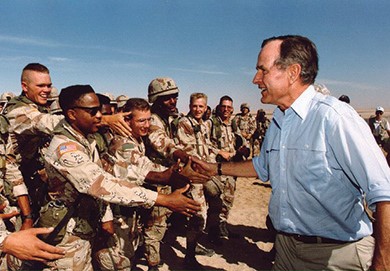
George H. W. Bush greets U.S. troops stationed in Saudi Arabia on Thanksgiving Day in 1990. The first troops were deployed there in August 1990, as part of Operation Desert Shield, which was intended to build U.S. military strength in the area in preparation for an eventual military operation. Source: Wikimedia Commons
A CHANGING DOMESTIC LANDSCAPE
By nearly every measure, Operation Desert Storm was a resounding success. Although Hussein was not removed from power, the war nevertheless suggested that the United States no longer suffered from “Vietnam Syndrome” and would deploy massive military resources if and when it thought necessary. Through deft diplomatic efforts on the international stage, Bush had ensured that many around the world saw the action as legitimate. By making the goals of the military action both clear and limited, he also reassured an American public still skeptical of foreign entanglements. With the Soviet Union vanishing from the world stage, and the United States demonstrating the extent of its diplomatic influence and military potency with President Bush at the helm, his reelection seemed all but inevitable. Indeed, in March 1991, the president had an approval rating of 89 percent.
Despite Bush’s successes internationally, the domestic situation at home was far more complicated. Unlike Reagan, Bush was not a natural culture warrior. Rather, he was a moderate, Connecticut-born Episcopalian, a pragmatic politician, and a life-long civil servant. He was not adept at catering to post-Reagan conservatives as his predecessor had been. By the same token, he appeared incapable of capitalizing on his history of moderation and pragmatism regarding women’s rights and access to abortion. Together with a Democratic Senate, Bush broke new ground in civil rights with his support of the Americans with Disabilities Act, a far-reaching law that prohibited discrimination based on disability in public accommodations and by employers.
President Bush’s weaknesses as a culture warrior were on full display during the controversy that erupted following his nomination of a new Supreme Court judge. In 1991, Justice Thurgood Marshall, the first African American ever to sit on the Supreme Court, opted to retire, thus opening a position on the court. Thinking he was doing the prudent thing by appealing to multiple interests, Bush nominated Clarence Thomas, another African American but also a strong social conservative.
The decision to nominate Thomas, however, proved to be anything but prudent. During Thomas’ confirmation hearings before the Senate Judiciary Committee, Anita Hill, a lawyer who had worked for Thomas when he was chairman of the Equal Employment Opportunity Commission (EEOC), came forward with allegations that he had sexually harassed her when he was her supervisor. Thomas denied the accusations and referred to the televised hearings as a “high tech lynching.” He survived the controversy and was appointed to the Supreme Court by a narrow Senate vote of fifty-two to forty-eight. In the aftermath, however, sexual harassment of women in the workplace gained public attention, and harassment complaints made to the EEOC increased 50 percent by the fall of 1992. The controversy also reflected poorly on President Bush and may have hurt him with female voters in 1992.
13.8 Section Summary
While Ronald Reagan worked to restrict the influence of the federal government in people’s lives, he simultaneously pursued interventionist policies abroad as part of a global Cold War strategy. Eager to cure the United States of “Vietnam Syndrome,” he increased the American stockpile of weapons and aided anti-Communist groups in the Caribbean and Central America. The Reagan administration’s secret sales of arms to Iran proved disastrous, however, and resulted in indictments for administration officials. With the end of the Cold War, attention shifted to escalating tensions in the Middle East, where an international coalition assembled by George H. W. Bush drove invading Iraqi forces from Kuwait. As Bush discovered in the last years of his presidency, even this almost-flawless exercise in international diplomatic and military power was not enough to calm a changing cultural and political climate at home.
Summary Timelines

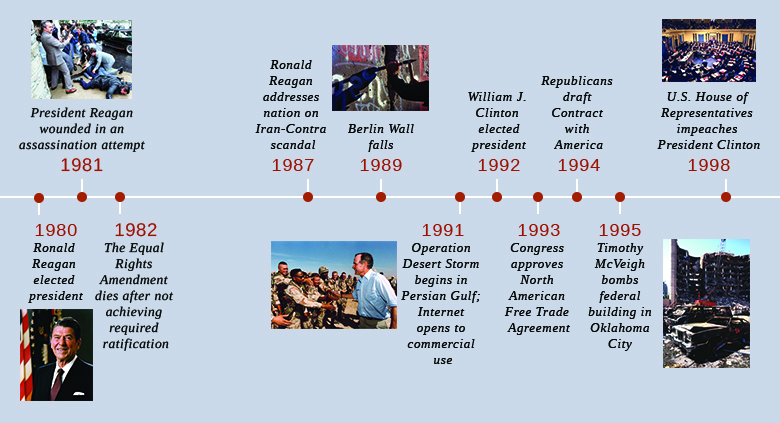
Chapter 13 Self-Test
Chapter 13 Key Terms Crossword Puzzle
Citations: This edited book is derivative of US History by P. Scott Corbett, et. al. CC BY 4.0. The original textbook is available at https://openstax.org/details/books/us-history
political movements or actions intended to further the interests of a particular group membership, based on culture, race, ethnicity, religion, sex, gender, or sexual orientation
a culture that develops in opposition to the dominant culture of a society
a political strategy that called for appealing to southern whites by resisting calls for greater advancements in civil rights
a majority whose political will is usually not heard—in this case, northern, white, blue-collar voters
conservative southern Democrats who opposed integration and the other goals of the African American civil rights movement
the Youth International Party, a political party formed in 1967, which called for the establishment of a New Nation consisting of cooperative institutions that would replace those currently in existence
high inflation combined with high unemployment and slow economic growth
the relaxation of tensions between the United States and the Soviet Union
the Nixon administration’s policy of turning over responsibility for the defense of South Vietnam to Vietnamese forces
government documents leaked to the New York Times that revealed the true nature of the conflict in Vietnam and turned many definitively against the war
the anonymous source, later revealed to be associate director of the FBI Mark Felt, who supplied reporters Bob Woodward and Carl Bernstein with information about White House involvement in the Watergate break-in
the right of the U.S. president to refuse subpoenas requiring him to disclose private communications on the grounds that this might interfere with the functioning of the executive branch
a loose coalition of American conservatives, consisting primarily of wealthy businesspeople and evangelical Christians, which developed in response to social changes of the 1960s and 1970s
Ronald Reagan’s economic policy, which suggested that lowering taxes on the upper income brackets would stimulate investment and economic growth
a deadly immune deficiency disorder discovered in 1981, and at first largely ignored by politicians because of its prevalence among gay men
a nationwide political campaign to implement harsh sentences for drug crimes, which produced an explosive growth of the prison population
reluctance on the part of American politicians to actively engage U.S. forces in a foreign war for fear of suffering a humiliating defeat
the U.S. name of the war waged from January to April 1991, by coalition forces against Iraq in reaction to Iraq’s invasion of Kuwait in August 1990

